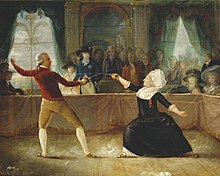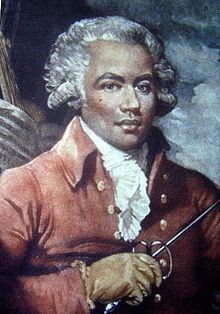Joseph Bologne, Chevalier de Saint-Georges
Joseph Bologne, Chevalier de Saint-Georges (born December 25, 1745 in Baillif , Guadeloupe , † June 10, 1799 in Paris ) was a French virtuoso violinist , composer and conductor . He was also an athlete and fencer and colonel in the Légion Saint-Georges during the French Revolution , the only black regiment in Europe at the time.
Life
Caribbean
Its exact origin has long been disputed. It is now believed that Joseph was born on Christmas 1745. The assumption of the Association du Chevalier de Saint-Georges that it was the illegitimate son of George de Bologne de Saint-Georges (1711–1774) seems to be correct. The mother was a 16-year-old slave, born in Guadaloupe named Anne Nanon, who had been in service for ten years and was widely praised for her beauty.
France
In 1747 George de Bologne was invited to a duel while visiting his uncle Samuel de Bologne . His opponent was injured in the process, but was initially able to go home without help. The man died three days later, likely from tetanus more than the wound itself, and George was charged with the murder. He fled from Basse-Terre and was sentenced in absentia on March 31, 1748 , "to be hanged and throttled to death on the gallows erected on the corner of the public square in this town of Basse-Terre". All of his goods were confiscated.
Between September 1748/49 the 3-year-old Joseph was taken by his mother (with the " stepmother " Elisabeth Mérican) to France, first to Bordeaux, then to Angoulême , where his uncle Pierre lived. In 1753 Joseph was sent to France for the second time. As a student he attended the Collège Saint-Louis in Angoulême. In 1755 the mother came to Paris with his father. As a 13-year-old he received fencing training in the fencing school of fencing master Nicolas Texier de la Boëssière. He also received musical training, probably from the violin virtuoso Pierre Gaviniès . From 1763 Joseph used his father's title. In 1764, at the age of 17, he was accepted into the “ Garde du corps du roi ” in Versailles. He was also active in music, with Antonio Lolli , Carl Stamitz and the composer and orchestra director François-Joseph Gossec dedicated some musical works to him.
First successes
Joseph Bologne, Chevalier de Saint-Georges, was especially popular with women because of his good manners and artistic and athletic abilities. He excelled in Paris society as a swimmer and ice skater. As a musician, he performed several times with Baron Karl Ernst von Bagge and Madame de Genlis , who played the harp. Saint-George's actual musical career began in 1769 when he joined the Concert des Amateurs (orchestra of amateurs) as the first violinist. In 1772 he made his debut as a composer. In 1773, as the successor to Gossec, Saint-Georges took over the direction of the Concert des Amateurs , which he made famous. In 1774 his father died in Guadaloupe, and his half-sister inherited the two plantations. In 1775, St. Georges was one of the first to introduce the symphony concertante and some quatuor concertants . In 1776, St Georges was the musical director of the Académie Royale de musique under discussion and planned to reform it. The resistance of some singers who refused to sing under a mulatto , a dancer who had a lot of influence on her patron, and the concerns raised by the court prevented her appointment. In 1777 his first opera, based on a libretto by Pierre Choderlos de Laclos , premiered in Théâtre-Italy , but was unsuccessful, mainly because of the disappointing libretto. Madame de Montesson invited him to live in her house and to play Mdm de Montalembert in her private theater. Louis Philippe I de Bourbon, duc d'Orléans , her husband, appointed him lieutenant de la chasse in Le Raincy . There he composes his second opera.
In the summer of 1778, St Georges lived for two months in the apartment of Baron Melchior Grimm and Louise d'Épinay , where the young Mozart also lived after his mother died on July 3 in Paris. St. Georges stopped composing orchestral works, but continued to conduct his orchestra. He made music with the young Marie Antoinette in the Petit Trianon . In 1780 he composed his third opera based on a libretto by Félicité de Genlis . In 1781 the Orchester des Amateurs was dissolved due to lack of funds.

St George was a member of the Masonic Lodge to the Nine Sisters , and the orchestra of the Lodge "de la Parfaite Estime et Société Olympique", which he directed, based in the Palais Royal , continued the Concerts des Amateurs. With 65–70 members - some professional opera musicians, some well-trained amateurs - it was the largest orchestra of its time. St Georges contacted Joseph Haydn for a composition and his “ Paris Symphony ” (No. 82–87), the “Olympique”, was premiered in 1784 under the direction of the Chevalier de Saint-Georges. In 1785 St Georges was invited by Louis-Philippe II Joseph de Bourbon, duc d'Orléans to stay in the Palais Royal. There he met Jacques Pierre Brissot , who in 1787 sent St Georges to London on a secret mission, where he met William Wilberforce , John Wilkes , and Thomas Clarkson . In 1788, the Société des Amis des Noirs was founded in Paris .
The revolution and the consequences

In May 1789, St Georges was present at the summoning of the Estates General of 1789 , but fled to London a few weeks later. Disappointed in Philippe Égalité , he moved to Lille in 1790 . St Georges was inducted into the National Guard as a captain . He also led an amateur orchestra in town. When Theobald Dillon was murdered by his own soldiers, St Georges was conducting a requiem that evening.
Since September 8, 1792, he had his own command with 1,000 soldiers from the French colonies under his command, the "Légion franche de cavalerie des Americains et du Midi". Thomas Alexandre Dumas was a lieutenant under him. From December he served in the Northern Army under General Joseph de Miaczynski . When Charles-François Dumouriez suffered a defeat at Neer winds in March 1793 , he settled in his headquarters in Saint-Amand-les-Eaux . Four convention officials and Defense Minister Pierre Riel de Beurnonville were sent to Lille to investigate its leadership. Dumouriez sent Miaczynski to Lille to arrest the agents. When General Miaczynski arrived in Lille on April 2nd and tried to win St Georges over to take part in a coup, the Polish general was arrested. Then Dumouriez tried to persuade his troops to invade Paris to overthrow the revolutionary government. The agents finally met Dumouriez to take him to Paris, but the general refused, had them arrested after lunch and extradited to Austria. The reign of terror began five days later .
Saint-Georges was denounced during the Reign of Terror by the Welfare Committee in September 1793 and imprisoned in Hondainville near Clermont (Oise) for eleven months (in letters he himself mentions 18 months). He was released in October 1794, but was not given a new command and was released a year later. In 1796 he took the opportunity to accompany a friend to Santo Domingo in Haiti , where François-Dominique Toussaint L'Ouverture had briefly set up a regime of mulattos that persecuted purebred blacks and whites alike. In 1797, Saint-Georges returned disappointed to Paris, where two years later he withdrew and became impoverished at Rue Boucherat No. 13 died.
Afterlife

In 2004 the artist's life was staged in the palace gardens of Versailles by the artist Bartabas in a historical spectacle. In 2003, Raymond Saint-Jean made the Canadian television film (“Le Mozart noir”) about his life. A street in Paris was named after him, and his hometown on Basse-Terre also honored him with a street and a memorial. The first named Rue de Chevalier de Saint-Georges in Guadeloupe names 1745 as the year of birth, while directly next to it the monument indicates 1739.
style
Musically, Joseph Bologne Chevalier de Saint-Georges belongs to the French classical music. His teachers and Gossec in particular shaped his instrumental and compositional style; Influences from the Mannheim School and from Joseph Haydn can also be seen. Like that of Gossec, his music is also strongly reminiscent of the young Mozart - although Saint-Georges and Gossec are to be seen more as his predecessors and role models and not the other way around. According to Banat, Saint-Georges is said to have had some influence on Beethoven.
Works
In addition to his work as a conductor and violinist, Saint-Georges composed 14 violin concertos , 2 symphonies , 18 string quartets or Quatuor concertant , 12 harpsichord and violin sonatas , songs and 6 operas. “L'Amant Anonyme” (1780) is the only opera that has survived. The 8 Sinfonia concertante (concerts for at least two soloists and orchestra) belonged to contemporary musical forms particularly cultivated by Saint-Georges and are said to have impressed and inspired Mozart, it is variously assumed.
Biographical sources
literature
- Gabriel Banat: Le Chevalier de Saint-Georges: Virtuoso of the Sword and the Bow , Pendragon Press, 2006.
- Daniel Marciano: Le chevalier de Saint-Georges, le fils de Noémie . France: Thespis, 2005.
- Luc Nemeth: Un État-Civil Chargé D'Enjeux: Saint-George, 1745–1799. Annales historiques de la Révolution française , 2005, N ° 1.
- Jean-Claude Halley: Chevalier de Saint-Georges raconte aux enfants. Editions Scérén - Crdp Guadeloupe, 2005.
- Claude Ribbe : Le chevalier de Saint-George. France: Perrin, 2004.
- Alain Guédé: Monsieur de Saint-George: Le nègre des Lumières. Arles, Actes Sud, 1999. English by Gilda M. Roberts, 2005.
- Emil Smidak: Joseph Boulogne nommé Chevalier de Saint-Georges. Lucerne: Avenira 1996.
- Odet Denys: Qui était le chevalier de Saint-George ?, 1972.
- Gaston Bourgeois: Le Chevalier de Saint-George: Mistakes His Biographers Have Made. In: Bulletin de la Société d'histoire de la Guadeloupe, 1964.
- Roger de Beauvoir : Le Chevalier de Saint-George (novel), 1840.
- Joseph Michaud (ed.) Biography Universal Michaud, vol. XXXIX, 1812.
- Thomas Betzwieser: Saint-Georges, Joseph Bologne, Chevalier de. In: MGG Online (subscription required).
Novels
Novels about his life have recently been written by Roland Brival (1991), Daniel Picouly (2003) and Daniel Marciano (2005) and most recently by Jan Jacobs Mulder (2018).
Children's book
- Lesa Cline-Ransome (Author), James E. Ransome (Illustrator): Before There Was Mozart: The Story of Joseph Boulogne, Chevalier de Saint-George , 2011. (English)
Movie
- Le Mozart noir. Reviving A Legend , documentary, Canada 2003.
Web links
- Full biography (English)
- Biography (English)
- Detailed catalog of works (French)
- Saint Georges Society website (French)
Individual evidence
- ↑ G. Banat, pp. 5, 55; [1] .
- ↑ G. Banat, p. 72.
- ↑ a b http://einarschlereth.blogspot.nl/2013/04/chevalier-de-sainte-george-und-napoleon.html
- ↑ G. Banat, pp. 24-26, 29.
- ↑ G. Banat, pp. 40, 42.
- ↑ G. Banat, p. 127.
- ↑ http://chevalierdesaintgeorges.homestead.com/Page1.html
- ↑ G. Banat, pp. 58, 59.
- ↑ G. Banat, p. 162.
- ↑ G. Banat, p. 171; Wolfgang Hildesheimer (1980) Mozart , p. 72.
- ↑ G. Banat, p. 175.
- ↑ G. Banat, pp. 152, 157.
- ↑ G. Banat, p. 373.
- ↑ G. Banat, p. 377.
- ↑ http://www.gauchemip.org/spip.php?article13524
- ↑ G. Banat, p. 396; Memoirs of General Dumourier (1794), p. 183. [2] .
- ↑ IMDB
- ↑ G. Banat, pp. 135, 166.
- ↑ Le Mozart noir in the IMDb .
| personal data | |
|---|---|
| SURNAME | Bologne, Joseph |
| ALTERNATIVE NAMES | Chevalier de Saint-George |
| BRIEF DESCRIPTION | French fencer, violin virtuoso, composer and conductor |
| DATE OF BIRTH | December 25, 1745 |
| PLACE OF BIRTH | Baillif near Basse-Terre (city) in Guadeloupe |
| DATE OF DEATH | June 10, 1799 |
| Place of death | Paris |



